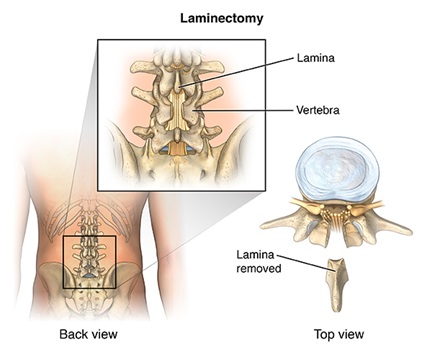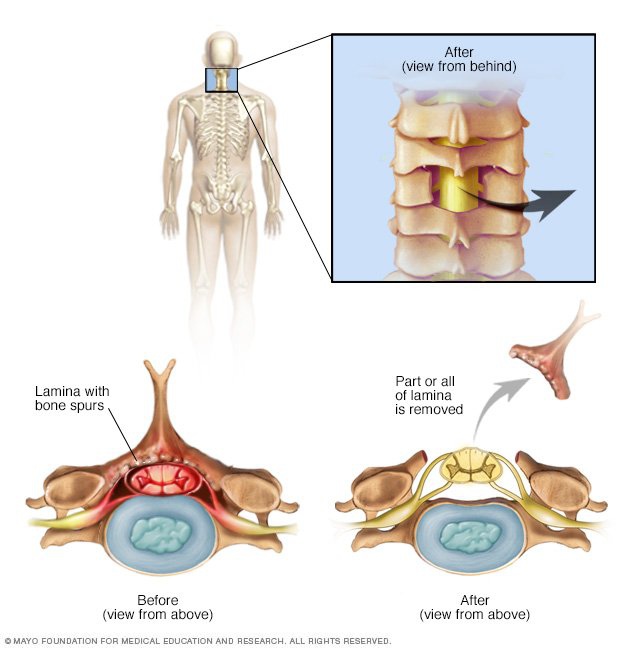
Laminectomy is also called decompression surgery. It helps create space by removing the back portion of the vertebra known as the lamina, which covers the spinal canal.
Laminectomy is one of the common surgeries of the back. It is done to relieve the pressure exerted on the nerves or the spinal cord by enlarging the spinal canal. The pressure exerted is usually due to the overgrowth of the bones in the spine, thickening of ligaments of the spine, disc prolapses, malalignment of the spine (also referred to as spondylolisthesis) or as part of surgery for removing spinal tumours or spinal stabilisation surgery.

The overgrowth of the bones in the spinal cord reduces the space present for the nerves and the spinal cord. This pressure exertion causes weakness, numbness, and pain that radiates to the arms and legs of the patient. Laminectomy is more useful in relieving these symptoms as compared to the actual back pain problem. The doctor may advise a laminectomy procedure due to the following reasons:
In degenerative spinal conditions, a laminectomy is done to relieve nerve symptoms such as sciatica. It is done in the cervical spine to relieve spinal cord compression as in cervical myelopathy or cervical radiculopathy.
A cervical laminectomy is the removal of the lamina in the neck area (cervical spine).

A lumbar laminectomy is the removal of the lamina in the lower back (lumbar spine).

The surgeon makes an incision in the patient’s back over the affected area or the vertebrae. He or she will separate the muscles and the tissues to easily assess the area to be treated. Small instruments are used by the surgeon to remove the lamina required.
If the laminectomy procedure is performed as a part of the slipped or herniated disk surgery, then the surgeon also removes the affected herniated part of the disk along with any broken and loose pieces. This is also known as a discectomy.
Spinal fusion is also done if the patient has a curvature of the spinal cord or one vertebra has slipped over the other vertebrae causing the nerves to press and resulting in severe pain. This is done to increase the stability of the spinal cord. In this procedure, the surgeon fixes two or more vertebras together permanently using bone grafts or metal screws or rods.
Depending upon the patient’s needs and condition, the surgeon may perform the surgical procedure by minimally invasive technique along with a special surgical microscope.
After the surgery is complete, the surgeon will close the incision site using sutures or staples.
Risks associated with any surgery are as follows:
Some problems related to laminectomy surgery are as follows:
In most cases, the surgical procedure of laminectomy has helped patients return to their work and relive the symptoms to a great extent. However, the effect of the surgery may reduce over time as the spinal cord starts ageing or if spinal arthritis has reoccurred. The laminectomy procedure is very effective in reducing the leg pain caused by the compression of the nerve as compared to back pain. Laminectomy surgery does not help in stopping the buildup from the problem of osteoarthritis. In this case leg pain is not due to nerve compression as a root cause. This may cause the symptoms to reappear with time.
Laminectomy is a common spine surgery and with new and advanced techniques of surgery, the risks of such surgery is very low.
After an open laminectomy, 85% to 90% of patients with lumbar central spinal stenosis find relief from leg pain. While 75% of the patients may experience satisfactory results for around 10 years post-surgery.
In most cases, there is no effect on the strength of the spine. It usually depends on the total tissue removed and if the spine has already weakened by previous surgery, arthritis, or degenerative changes.